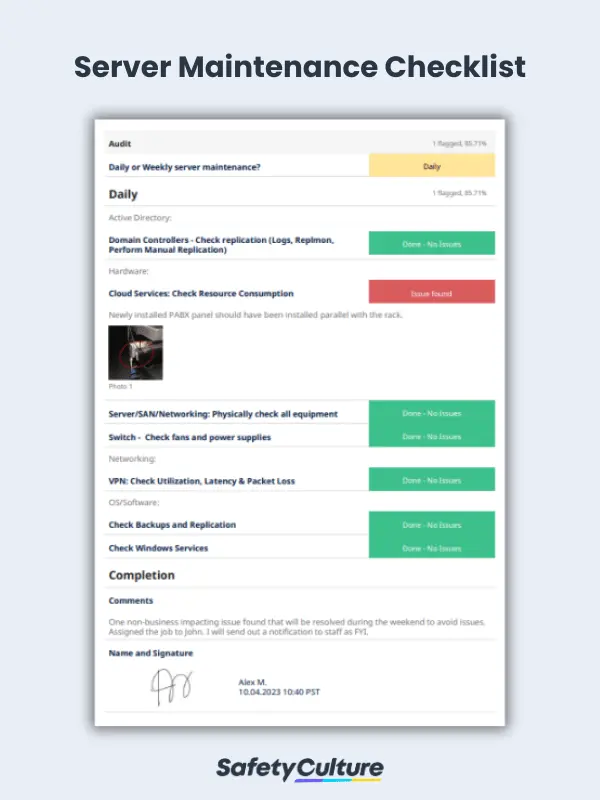What is a Server Maintenance Checklist?
A server maintenance checklist is a tool used by IT professionals when conducting routine server maintenance. They list tasks that should be completed on a regular basis (daily, weekly, monthly, etc.) in order to ensure the continuous and optimum performance of servers.
What is Server Maintenance?
Server maintenance is a task performed on a server or a group of servers to ensure their smooth operation, reliability, and security. It involves a series of activities, including hardware inspections, software updates, security patch installations, performance optimizations, backup procedures, and troubleshooting.
Why is it Important?
By conducting server maintenance, organizations can proactively address potential issues, prevent system failures, improve performance, and ensure the uninterrupted functioning of their servers, which are crucial components of their IT infrastructure.
Conducted with a server maintenance checklist, server maintenance intends to proactively catch issues before they cause costly and unscheduled downtimes that disrupt business operations. Server maintenance is also done whenever a server issue occurs to minimize possible operational downtimes and prevent its recurrence.
What is Included in Server Maintenance?
Whether performing daily, weekly, monthly, or any of the scheduled server maintenance – sustaining the optimum performance of servers involves completing a list of items that target these key areas:
Keep OS/software up-to-date
There’s a need to be up-to-date with OS updates, application updates, patches, and security updates to make sure that bugs are fixed and that your system is safe from threats. This helps enhance security, stability, and compatibility while ensuring that servers are equipped with the latest features and performance improvements.
Perform hardware inspection regularly
Check the server room’s temperature, airflow, and humidity, and make sure there’s no dust and debris that can disrupt airflow. This includes hardware components such as hard drives, power supplies, fans, and cables— ensure that they are functioning properly and are free from physical damage or excessive wear.
Analyze and review server logs
Proactively check logs and error reports to identify any anomalies, errors, or warning signs that may indicate potential issues or security breaches. Take necessary actions based on the analysis to mitigate risks and resolve problems that can potentially disrupt operations.
Verify user access
Deactivate the system access of persons who are no longer associated with the company because unauthorized access is a huge threat to information security. Implement security protocols, such as firewall configurations, intrusion detection systems, antivirus software, and access controls, to safeguard servers from unnecessary access, data breaches, and malware threats.
Top Server Maintenance Tips
The process of server maintenance can vary per organization and their specific needs and what they consider to be critical, but it is always best to follow a set of practices that they can use as a guide.
Below are the top server maintenance tips:
- Install the latest OS and application updates
- Check for security updates and patches
- Inspect hardware optimal temperature and its components for debris
- Deactivate access of persons no longer with the company
- Establish a reliable backup strategy to protect critical data and configurations
- Perform scheduled maintenance regularly
- Use server checklists for maintenance work
- Document server configurations to help in troubleshooting, disaster recovery, and knowledge sharing
- Set up redundancy and failover mechanisms to mitigate the impact of hardware or software failures
- Test disaster recovery plans to ensure their effectiveness
Benefits of Using a Server Maintenance Checklist
Using a checklist during server maintenance offers a lot of benefits not just for the organization but also for the person that performs the maintenance. It helps ensure that all important items are covered, and issues are recorded and properly addressed.
Employing the use of checklists for server maintenance also encourages a consistent and systematic process between shifts and IT teams working around the clock to ensure the uninterrupted operation of servers.
In addition to their practical benefits, the checklists filled out during server maintenance also serve as valuable documentation that can fulfill the requirements of various certifications for international standards. Certifications such as ISO 27001 that sets the framework for Information Security Management System often demand comprehensive documentation of server maintenance activities. By diligently completing and maintaining these checklists, organizations can demonstrate compliance with the necessary standards and regulations, showcasing their commitment to maintaining a secure and reliable server infrastructure.
To view a completed server maintenance, preview this Server Maintenance Checklist PDF report.
FAQs About Server Maintenance
The various types of server maintenance include tasks such as hardware maintenance, software maintenance, security maintenance, backup and recovery maintenance, and performance maintenance. All of these maintenance tasks are done to enhance server performance and prevent disruptions to business operations.
It is necessary to perform routine checks for servers at least once every year, but it is generally recommended to conduct server maintenance regularly. The frequency—daily, weekly, monthly, or quarterly—depends on factors such as the type of server, the amount of usage, and the criticality of the server to business operations.
The maintenance of servers is typically performed by various groups or individuals, such as a dedicated IT team, a system administrator, or a service technician. In some cases, it may also be outsourced to a third-party provider.


